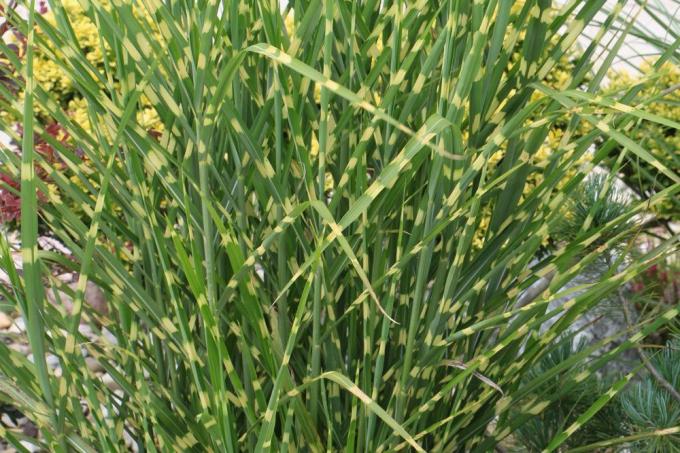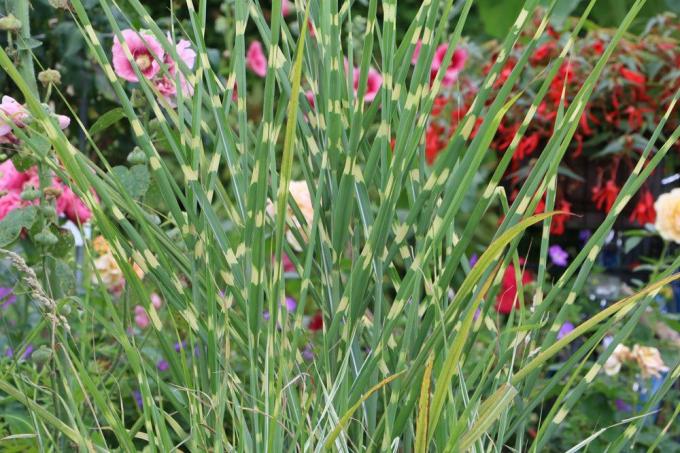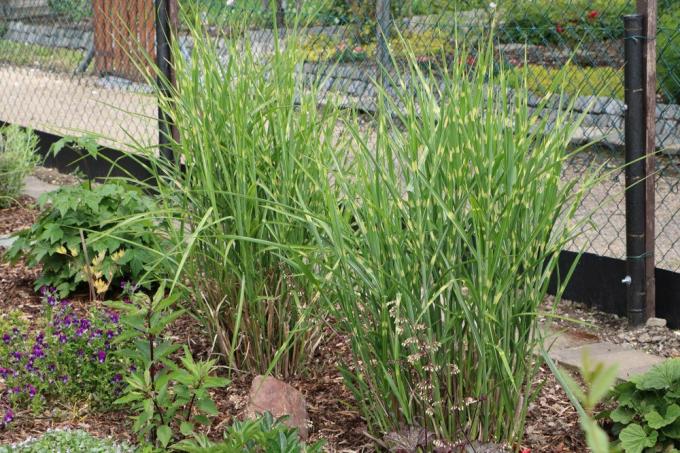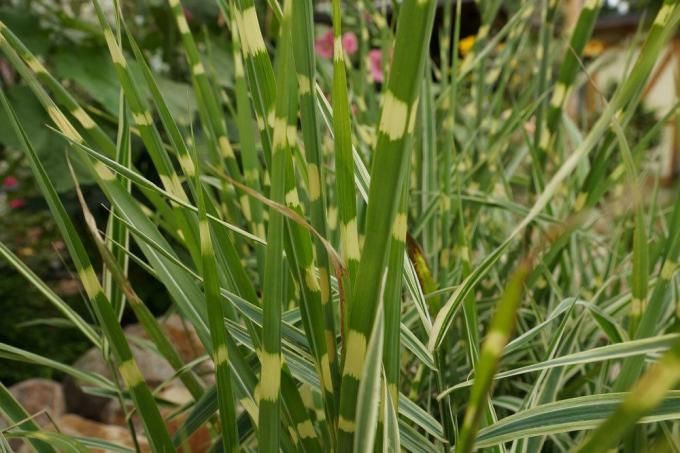
table of contents
- Location
- plants
- care
- to water
- Fertilize
- Cut
- Multiply
- Diseases
- species
Profile and care information open +conclude -
- Flower color
- White
- Location
- Partial shade, sunny, full sun
- Heyday
- August September October
- Growth habit
- upright, bushy, clump-forming, overhanging
- height
- up to 160 centimeters high
- Soil type
- sandy, loamy
- Soil moisture
- moderately moist, fresh
- PH value
- weakly alkaline, weakly acidic
- Limescale tolerance
- Calcium tolerant
- humus
- rich in humus
- Poisonous
- no
- Plant families
- Sweet grasses, Poaceae
- Plant species
- Ornamental grasses, hedge plants, bedding plants
- Garden style
- Residential garden, ornamental garden, hedge garden
The different varieties of Chinese reed, including tiger grass (Miscanthus sinensis zebrinus), are still a rare sight in our gardens. But there are more and more plant lovers who appreciate the charm of grasses. Among the ornamental grasses, the zebra Chinese reed is a real beauty, because its green leaves are adorned with yellowish horizontal stripes, from which the common name is derived. Because of its easy maintenance, the zebra grass is also suitable for beginners.
Location
The zebra Chinese reed is very versatile. On the one hand, it sets accents in the garden on its own, because the ornamental grass reaches a considerable height and is also a real eye-catcher due to its distinctive stripes. Planting in the perennial bed is also particularly attractive, where the ornamental grass protrudes like a column in the midst of taller perennials such as loosestrife, sage or scented nettles.
Zebra grasses grow very dense and bushy, making them ideal as a hedge plant. So if you would like a natural fence in your garden or are you still looking for the right object to cover less beautiful areas, the zebra grass is the perfect choice. The sunnier the tiger grass, the more intense its characteristic stripes.

- Light requirement: full sun to very light partial shade
- If the locations are too dark, the grass loses its attractive horizontal stripes
- preferably near a garden pond
- also suitable for planting near the shore
- Specimen plant
- Hedge planting
- as a privacy screen
- Open spaces
- Flower beds
- Grasslands
Soil / substrate
The condition of the soil is particularly important for healthy growth. Loose soils, which on the one hand store the water well, but on the other hand can also easily drain it off, offer ideal conditions for the zebra Chinese reed. Although the striped ornamental grass needs sufficient amounts of moisture, it should not stand in the wet for a long time.
- moist and fresh
- well permeable
- pH value: slightly acidic to slightly alkaline (5 to 7.5)
- loamy-sandy with a slight humus content
- nutritious
- Substrate for potted plants: high quality substrate for potted plants
- alternatively a mixture of humus green plant soil, sand and gravel
- If necessary, also install a root barrier in the field
plants
In principle, the zebra reed can be planted over the entire growth period. The best time is in spring so that the roots can establish themselves well in the ground. If the sweet grass is to be cultivated in the tub, planting is possible until August. It is best to pay attention to the right location when planting, because later repositioning is a bit time-consuming due to the extensive root runners. In order to provide the tiger grass with good conditions for healthy growth right from the start, the soil should be prepared before the ornamental grass is set.
- add compost and clay to sandy soils
- First provide heavy soils with a drainage layer
- Mix sand, grit and humus into the garden soil
- Time: spring or early autumn
- Planting hole: about twice the width and depth of the root ball
- Plant spacing: 1 m for the upright version, a little more for the overhanging version
- Plants per square meter: 1
- water well before planting
- Slightly loosen the roots at the edge by hand

If the zebra grass is planted in a perennial bed or a small garden and should not expand in an uncontrolled manner, it is best to build a root barrier right away. But don't place them too tightly around the plant. About a meter in diameter is necessary for the sweet grass to thrive healthily and vigorously.
Bucket culture
Miscanthus sinensis zebrinus grows relatively slowly, but reaches a stately height of over 150 cm. Therefore, when planting in a tub, make sure that it is heavy enough to offer sufficient stability in windy conditions.
- Clay vessels are best
- offer good stability and optimize the water balance
- Use a flat saucer instead of a planter
- facilitates moisture control
care
If the tiger grass is offered a suitable location and a suitable substrate, the sweet grass hardly makes any work and is not very susceptible to diseases or pests.
to water
In order for the zebra reed to grow and thrive, it needs a lot of moisture. It must therefore be watered regularly in dry regions. The root ball must never dry out completely, because the leaves of the grass quickly turn brown and the damage caused by the drought is irreparable. In hot periods it is necessary to water potted plants in the morning and in the evening and, if possible, even to leave some water in the saucer. Avoid waterlogging at all costs, otherwise root rot will form, which may cause the entire zebra grass to die off.
Fertilize
Fertilization takes place exclusively in the growth phase between April and the beginning of August. Since the tiger grass is sensitive to high salt concentrations, it is preferable to use organic slow-release fertilizers instead of mineral fertilizers that are administered via the irrigation water.
For outdoor plants, ripe compost is suitable for fertilizing, which is mixed into the garden soil in spring. Container plants are made with horn meal or Horn shavings easier to supply with nutrients. In a pinch, a container plant fertilizer can also be used, but only use highly diluted concentrations at four-week intervals to fertilize Miscanthus sinensis.
Repot
In contrast to established, older plants, young tiger grasses still grow quite quickly. For this reason, the root ball must be checked at least twice a year in the first few years. If the fine roots are already forming a dense network on the outside and at the bottom of the ball, it is time for a larger pot.
To keep the long stalks out of the way, it has proven useful to tie the leaves together at the top with a rope when repotting. Do not pull the zebra grass out of the pot by the stalks; the thin leaves cannot withstand strong pulling forces and will tear off. After binding, the approach can be better grasped above the ground and pulled out of the pot.
- Time: at least once a year in spring
- more common in young plants
- Carefully pull the bale out of the pot
- shake off old earth
- Slightly tear or cut into the root network at the edge
- that makes it easier to grow
It is best to wear gloves when repotting. The zebra reed is not poisonous, but its stalks are very sharp, so that they can cause nasty cuts.
Cut
When the first frosts occur, the striped leaves of the zebra grass die off and dry up. The roots survive the winter in the ground and the plant sprouts again in early spring. Miscanthus sinensis is pruned just above the ground once a year. Many gardeners cut their ornamental grasses as early as autumn, when the leaves change color. That is actually a shame, because the zebra grass also provides wonderful highlights in the winter garden, for example when the Snow remains on the delicate leaves and ears of wheat or at times when the hoarfrost causes bizarre crystals on the plant conjures.
Cutting the ornamental grass is one of the activities that are essential for the growth and healthy growth of the plant. Ideally, cut back in April, when the first fresh green stalks have already formed. But don't wait too long, otherwise you'll have to cut each stalk of the previous year individually so as not to damage the fresh shoot.

Every three to four years it is necessary to divide the lush tiger grass or at least cut off some of the runners with a spade. Otherwise the zebra Chinese reeds will quickly overgrow entire beds. This measure has another advantage, because the grass is rejuvenated at the same time, so that it can grow stronger and healthier.
Toxicity
The zebra grass is a sweet grass and is therefore not poisonous. Herbivores among domestic animals such as rabbits or guinea pigs, which are allowed to roam freely in the garden, even occasionally feed on the zebra Chinese reed. You can do this without hesitation, because the ornamental grass does not pose any risk to the health of the animals. In the worst case, the tiger grass is so popular that its external appearance leaves a lot to be desired from being eaten by animals and the plant has to be protected.
Hibernate outdoor plants
In most regions, the tiger grass can easily overwinter outdoors. Only in very windy areas with long periods of frost is it advisable to provide additional protection. Many hobby gardeners cut their zebra Chinese reeds back in autumn when the grass slowly dries up. This measure does not make sense, because the dry stalks offer the plant good protection against cold and moisture.
The zebra grass does not tolerate both of these very well, even if we classify it as sufficiently hardy (down to -20 degrees). It is therefore advisable not to cut back the grass until spring, when new growth is about to begin. It has proven useful to tie the long stalks together with a rope at the top of the forelock. In this way, the heart of the ornamental grass is better protected from the cold and wet.
Hibernate potted plants
A little more attention must be paid to zebra grasses during the winter, which are cultivated as potted plants. Place the plant near the house, protected from winds and heavy rain.
- Time: before the first frosts in October
- Wrap the tub with fleece or packaging film
- Place the pot on a thick styrofoam plate
- Tie the blades of grass together at the top
- possibly also tie a jute sack around the leaves
- place against a warm house wall
- preferably under a roof
Do not forget to water on frost-free days, because the roots should never dry out completely, even in winter.

Multiply
There are several ways to multiply the zebra mina. When the plant produces flowers, the seeds can be collected and sown. It is much easier and faster to multiply by dividing or by root runners.
Offshoots / parts
Zebra grass forms root runners, so-called rhizomes or offshoots. As a result, the sweet grass grows continuously in width. Once these rhizomes have reached a certain size, they can survive on their own even without the supply of water and nutrients from the mother plant. Therefore, they can simply be separated and planted in a new place. This works best if the tiger grass is divided every three to four years anyway or pieces are cut out with a spade so that the plant does not get too big.
- Time: ideally immediately after the pruning
- completely dig up younger plants
- Use a spade or sharp knife to cut the bale in two
- In the case of old, established plants, cut off the sides with a spade or an ax
- Immediately replant individual parts and water them well
Since Miscanthus sinensis spreads strongly through cuttings, it is necessary to divide the plant about every three years, even if it is not intended to multiply. Above all, plants in pots or outdoor plants that are provided with a root barrier will otherwise begin to bald from the inside out.
sowing
Growing from seeds is possible all year round indoors. However, since the zebra grass rarely blooms here, seeds will probably have to be bought from specialist retailers.
- Substrate: cactus soil, seed soil
- Fill substrate into pots or seed trays
- moisten
- Press the seeds lightly into the substrate
- Cover the planter with cling film
- pierce a few ventilation holes
- ventilate every two to three days
- remove the cling film for 2 hours
- Location: bright and warm
- Temperature: 20-25 degrees
- Germination time: about three weeks
After germination, you can separate the small plants in 9 to 12 cm pots and keep them bright and slightly damp. Since Miscanthus sinensis grows strongly at first, a larger planter is necessary at regular intervals.

Diseases
The zebra Chinese reed is one of the robust grasses that rarely get sick. Although pests such as aphids or whitefly occur occasionally, this is very rarely the case. When the porcupine grass begins to die, it is usually the fault of care mistakes. The leaves turn brown if the water balance is wrong. There are various possible reasons for this:
dryness
The zebra grass is very sensitive to drought. Its root ball must never dry out, because that leads to the death of the leaves within a very short time. So on hot days it is not enough to just water the grass once a day. Usually it has to be watered at least twice (morning and evening).
It is best to leave some irrigation water at the bottom of the bowl so that it can be soaked up during the day. Container plants are hardest hit by drought. If you want to prevent the tiger grass from turning brown, simply place the pot in a little more shade. This will reduce evaporation from the leaves.
Root rot
Just like drought, Miscanthus sinensis does not tolerate waterlogging. Although the root ball must always be slightly damp, permanent wetness leads to rottenness and death of the roots. In addition, pathogens penetrate through the injured roots, which further weaken the ornamental grass. If action is not taken quickly and the dead roots are generously removed and the substrate replaced, the zebra grass will die.
If the weather conditions are sunny and hot, there is hardly any risk of waterlogging. However, the cooler the temperatures, the less water the plant needs. It is best to check before pouring whether the top layer of substrate is already slightly dry. In this case it has to be watered again. If it is cool, you should remove excess water from the coaster.

species
Miscanthus sinensis zebrinus is a special kind of Chinese reed and belongs to the sweet grasses (Poaceae). As the name suggests, these grasses are native to Asia. If the summer is long and warm, the yellowish striped ornamental grass also blooms in our latitudes. However, only when it has reached its full level after four to five years.
Then from August long, upright ears appear on the plant, which take on a slightly silvery tone. There are two different types of ornamental grass available in stores. Both differ essentially in their growth habit. While the leaves of one variant overhang slightly, the leaves of the second form are upright.
Shape with overhanging tuft of leaves:
- Miscanthus sinensis zebrinus
- Miscanthus sinensis Little Zebra
Strictly upright growing form:
- Miscanthus sinensis strictus (tiger grass, stiff zebra china reed, porcupine grass)
While the overhanging variant is up to 1.5 meters wide, the upright form grows much more compact and reaches about 1 meter in width. Both variants reach a maximum height of 1.6 meters.



